There’s a reason for a “sterile cockpit.”
The other day, I wrote a blog post about the four recent helicopter crashes that occurred during cherry drying operations here in Washington State. My point was to explore the possibility that pilots and operators were not taking this potentially dangerous work seriously. You can read that post here.
In giving this some more thought, I think that post neglected another indicator of not taking this work seriously: the concept of flying in a distraction-free environment — a so-called “sterile cockpit.”
Sterile Cockpit Defined
From Wikipedia:
The Sterile Cockpit Rule is an FAA regulation requiring pilots to refrain from non-essential activities during critical phases of flight, normally below 10,000 feet. The FAA imposed the rule in 1981 after reviewing a series of accidents that were caused by flight crews who were distracted from their flying duties by engaging in non-essential conversations and activities during critical parts of the flight.
Obviously, most — if not all — of a helicopter’s operations are below 10,000 feet. And helicopters performing cherry drying services aren’t subject to the same rules as airliners. So my point isn’t that helicopter operators are required to follow this rule. My point is that this rule exists for a reason.
When I went through the process of getting my Part 135 certificate, the topic of maintaining a sterile cockpit was brought up. My FAA POI was concerned about distractions during critical phases of flight. For my Part 135 operations, which consist primarily of tour and air-taxi services, that meant times when I’m in tower-controlled airspace, when I’m landing, or when I’m taking off. It also meant phases of flight operated at or below 300 feet AGL. The point being that when I’m communicating with a tower or close to the ground, I need to minimize distractions.
Distractions come in many forms. My POI’s main concern for me was chatty passengers. While I can normally perform landings at easy landing zones (LZs) without any problems — even while conducting a conversation with someone — when you add the need to listen to and look for other traffic, communicate with a tower, or deal with unusual conditions such as crosswinds or difficult landing zones, things are tougher.
For example, just the other day a very chatty passenger decided to start a new conversation just as I was on final approach to an off-airport, confined area LZ with a crosswind of 29 mph gusting to 36 mph. (We were about 1/2 mile from the airport, so that reading comes from an AWOS and is accurate.) When I didn’t answer her second question, she got the message and shut up. I have a switch I can flick to turn off cockpit chatter among passengers, but since I don’t usually need to use it, I didn’t flick it for that flight. Although the landing was fine, I’m thinking of a better briefing for passengers in the future.
Maintaining a sterile cockpit means eliminating all non-essential communication. It means reducing or eliminating distractions during critical portions of the flight.
Sterile Cockpits in Agricultural Work
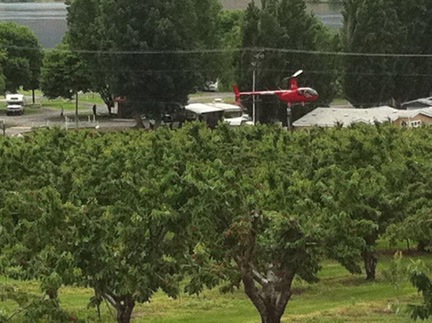
This is a photo I won’t show my mother. The helicopter’s airframe is probably about 20-25 feet from the wires in this shot by Patrick Schroeder. That’s as close as I’m willing to get.
Agricultural flying such as spraying, frost control, and cherry drying can be pretty intense. All of them require precision flying. Spraying is low level, at a relatively quick speed. Frost control is very low level, pretty slow, and usually done at night. Cherry drying is very low level and very slow, sometimes during or after weather that can obscure cockpit views. Obstructions are usually a concern for all agricultural flying work. These are conditions and flight profiles that could definitely benefit from a sterile cockpit.
I don’t think it’s a coincidence that most aircraft set up for spraying — whether they are helicopters or airplanes — are either labeled “Experimental” or have just one seat. These are not aircraft set up for passenger flight.
Imagine this scenario: A helicopter pilot is sent out to do some cherry drying. He’s been hanging around all day with a buddy who might even be another pilot. He invites him to come along. They head out over the orchard and the pilot gets to work. While he’s flying, he and his buddy are talking. Maybe one of them tells a joke and they laugh. Or maybe the buddy is texting with someone they both know and is relaying the conversation to the pilot. Or, worse yet, maybe the companion shows the pilot a photo from last night’s trip to the local sports bar on his smart phone. The pilot is not giving his full attention to the task at hand. He’s being distracted by his companion.
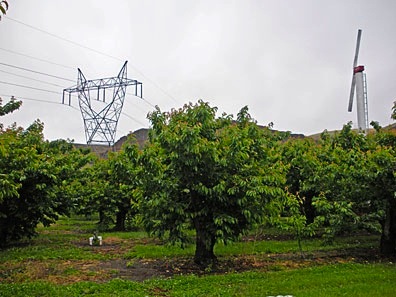
Who plants cherry trees under wires? Too many growers.
This isn’t so far-fetched — especially in a situation where the pilot and passenger aren’t taking the work seriously. Sure, the pilot is just hovering and the pilot has been doing that since he learned to fly. It’s not very difficult for an experienced pilot to do. But add obstructions and wind gusts during slow flight and it isn’t quite as easy. It requires more concentration — less distractions.
A sterile cockpit.
A Coincidence?
There were two people on board when three of the four cherry drying crashes occurred in this area over the past twelve months. I pointed this out in my recent blog post, but didn’t really think about the second person as a cause of distraction.
Could that have been a contributing factor? That the pilot was not focused on the work and allowed himself to get into a dangerous situation? That he didn’t react promptly because of distraction?
It’s certainly something to think about.

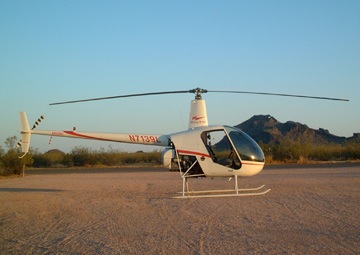
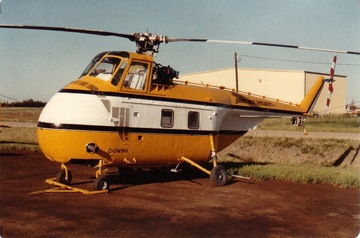 Here’s an example of a Sikorsky S-55C. Photo from
Here’s an example of a Sikorsky S-55C. Photo from  Cherry drying is very unforgiving work. In most cases, you’re hovering less than 40 feet off the ground over treetops at less than 10 miles per hour. That’s right, smack dab in the
Cherry drying is very unforgiving work. In most cases, you’re hovering less than 40 feet off the ground over treetops at less than 10 miles per hour. That’s right, smack dab in the  The sky was intensely dark out toward the river and the storm was definitely heading in my direction. But what was even scarier was the low hanging cloud near me that seemed to be swirling gently like something from a Weather Channel tornado special. I watched it for a while, wondering whether the storm was really intense enough to get a tornado going. It didn’t seem to be.
The sky was intensely dark out toward the river and the storm was definitely heading in my direction. But what was even scarier was the low hanging cloud near me that seemed to be swirling gently like something from a Weather Channel tornado special. I watched it for a while, wondering whether the storm was really intense enough to get a tornado going. It didn’t seem to be. I came in over the orchard in a grand, swooping arc, settling in at the southeast corner in a hover over trees nearly as old as I am.
I came in over the orchard in a grand, swooping arc, settling in at the southeast corner in a hover over trees nearly as old as I am.

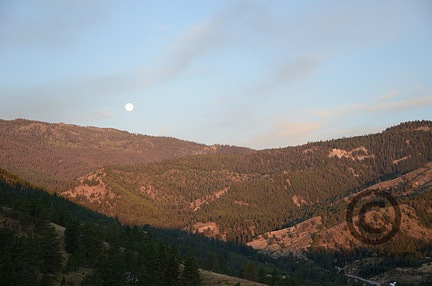



 I use
I use